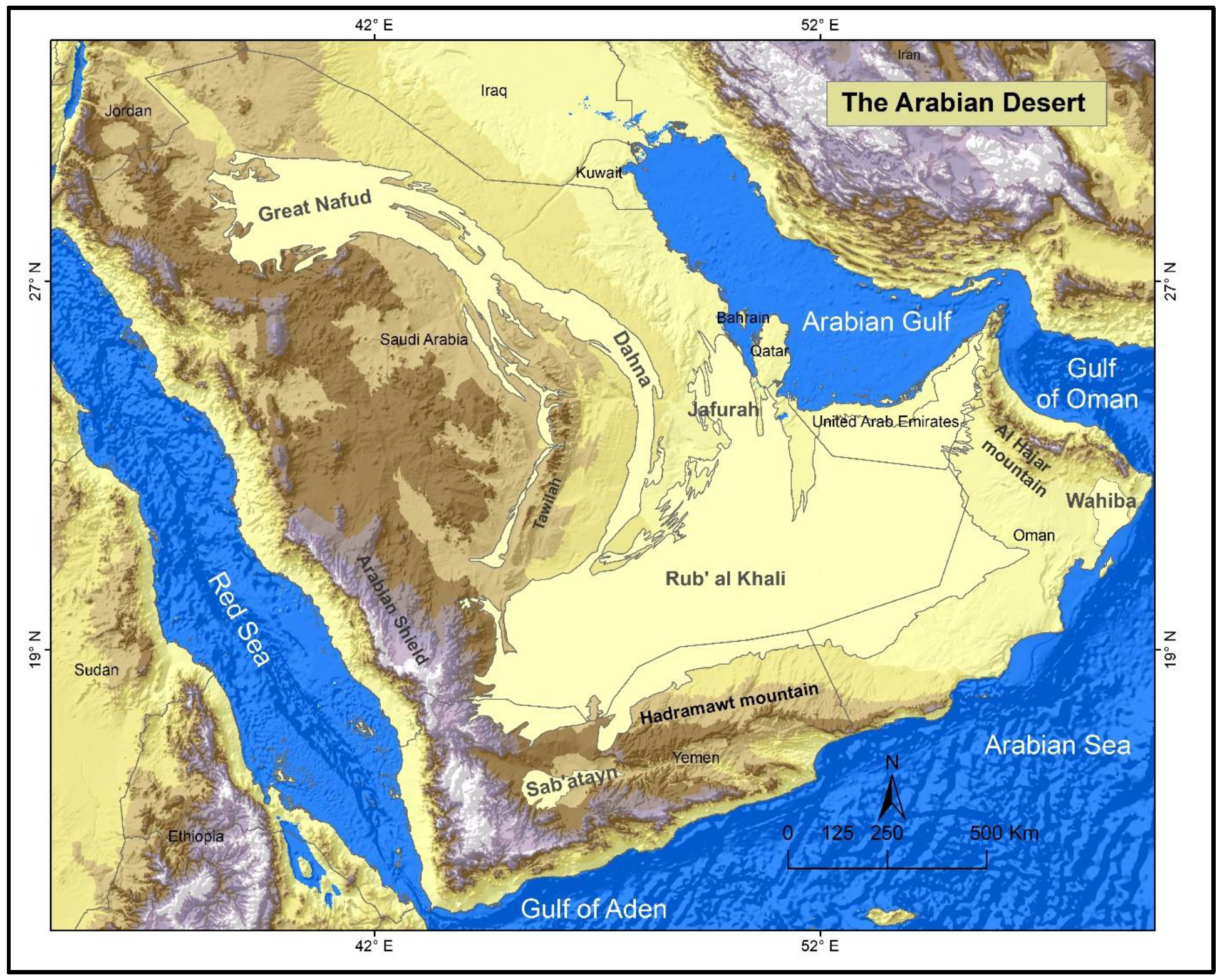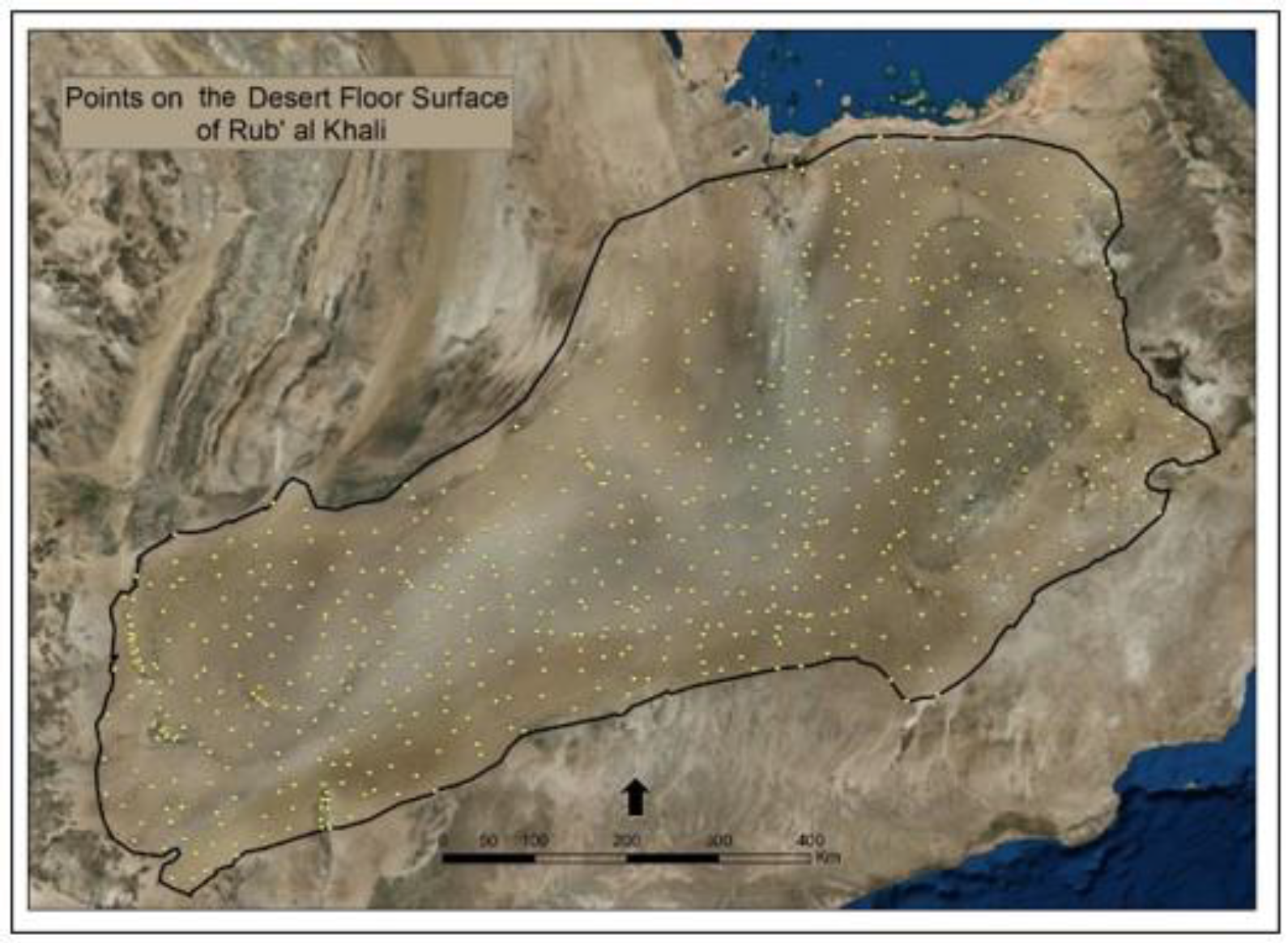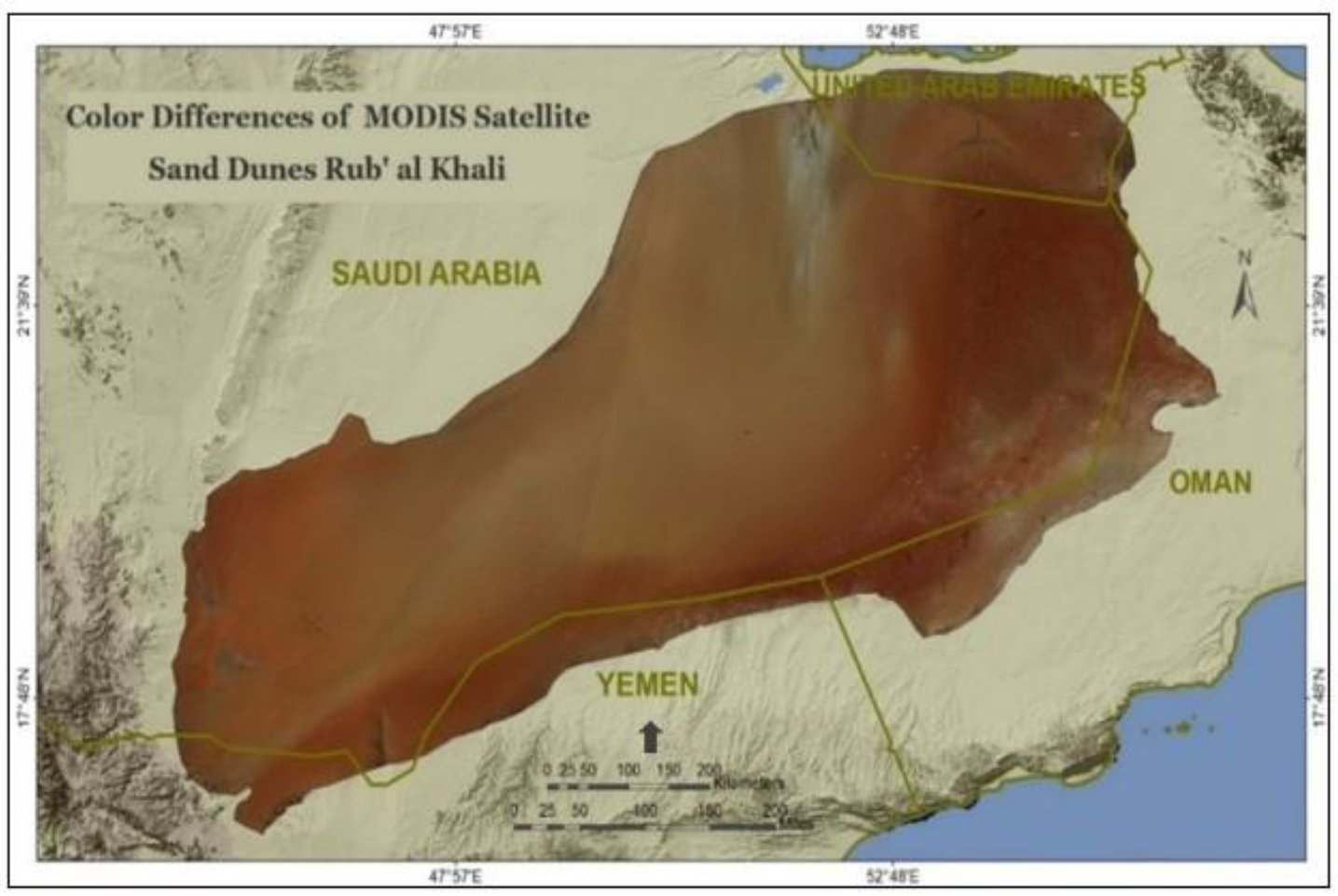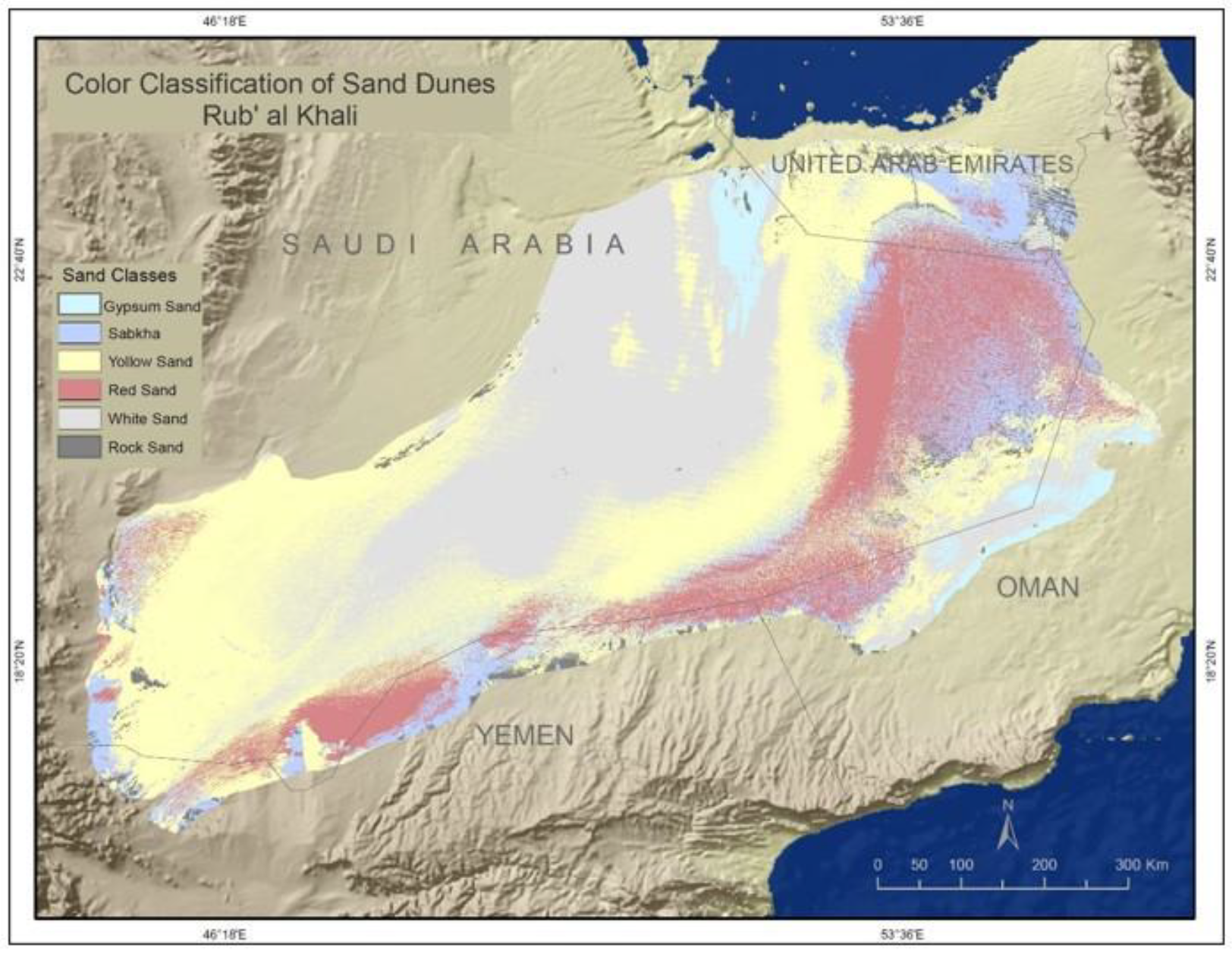1. Introduction
A question has always existed as to the reason why such a huge amount of quartz sand exists in the Rub’ al Khali, while the surrounding geology consists largely of carbonates [
1]. This observation raises interesting questions with regard to the origin and age of the dunes. Given the eastward orientation and slope of the Rub’ al Khali basin and the alignment of dunes with respect to dominant northwest winds, there is a strong consensus that the sand dunes have developed from both local and regional sources [
1,
2]. In this regard, [
3] was the first to suggest that wadis flowing eastward from the Arabian Shield mountains contribute local sand to the western part of the dune field. More importantly, [
4,
5] recognized that the Arabian Gulf was dry during the last glacial maximum (17,000–25,000 BP) when sea level was about 120 m lower than today. With the dry Arabian Gulf exposed as a source, winds from the northwest could transport an enormous volume of sand over a period of thousands of years. To investigate the potential sources of sand and estimate the total sand volume in the Rub’ al Khali based on sand dune color, field investigation, laboratory analysis of sediments, and visual interpretation of satellite data are required to be considered.
To date, there does not appear to be any research undertaken to classify satellite imagery based on the spectral signature of the dune sand. Yet, these color differences are evident in satellite imagery. In this regard, the color of the sand surface is important because it should be related to the composition and/or age of the sand, both of which are relevant to understanding the potential sources.
Recognizing that the dunes within the Rub’ al Kahli are composed of sand from several different sources then leads to the next basic question. How much sand is there in the Rub’ al Khali, and what percent of this sand is derived from different sources? As our understanding of potential sources becomes more refined, future research might be able to quantify the relative volume from different sources, but for now, there does not appear to be any quantitative estimate of the total volume of sand. The objective of this study is to analyze satellite imagery to identify and map significant differences in sand dune colors. While this analysis does not attempt to identify particular sources of sand, these color differences can be used to identify different regions of the dune field that might share a common source or might be a common age.
3. Results
The results of this work are very encouraging to estimate the sand volume for each sand dunes color of determent potential sources within the Rub’ al Khali. The volume of the dune fields is an important variable in the numerical simulations used to study dune field dynamics [
25]. To map the distribution of sand volume, the elevation of the desert floor beneath the dunes can be subtracted from the elevation of the dune surface. Conceptually, this process is rather straightforward, but creating a map of the desert floor beneath the dunes represents a challenging problem. In this analysis, several different methods are developed to map the desert floor beneath the dunes.
Figure 7 shows the surface of the desert floor underneath the sand dunes for four different analysis methods. Comparing the four maps, the overall pattern of elevation contours is similar, although there are noticeable differences in detail. While all four maps capture the eastward slope of the Rub’ al Khali basin, the elevation surfaces created from three interpolation methods are much smoother, and the surface created using the minimum focal statistics is far more detailed.
The next step is to estimate the volume of the sand dune in the Rub’ al Khali. While the desert is recognized as the largest sand sea in the world, there does not appear to be any published estimate of total sand volume, and there is certainly no map showing the spatial distribution of sand volume throughout the dune field. Some parts of the dune field contain massive dunes representing a huge volume of sand. In other parts of the dune field, the sand dunes are much smaller.
Table 2 shows the results of the volume analysis, expressed in trillions of cubic meters (thousands of billions). Comparing the volume calculations in this table, it becomes obvious that the three volumes derived by interpolating the desert floor from point elevations are quite similar, ranging in value from 7718 billion m
3 for IDW to 8261 billion m
3 for the spline. The difference between these two values is only 6.6%. Moreover, the volume derived from the kriging interpolation, 7903 billion m
3, is midway between the outside estimates. The focal statistic method shows a volume of 11,010 billion m
3 which is higher than the other discussed methods that will be discussed in the following pages.
Furthermore, the image mosaic of the Rub’ al Khali was configured in a true color composite. In this mosaic, there are obvious differences in the color of the sand surface. The eastern part of the dune field appears as a noticeably dark brown when compared to the rest of the dune field. In a similar manner, the southern margin and western edge also appear as a dark brown, although this brown color is slightly lighter. Equally important are the two major light-colored intrusions, one emerging from the northern margin of the dune field and one emerging from the southwest corner of the dune field. In particular, this light-colored intrusion from the southwestern edge of the dune field seems to extend all of the way into the interior of the dune field for almost 800 km. Analyzing differences in the sand surface of the dune field using satellite imagery is difficult owing to the similarity in the texture of the surface and the nearly homogeneous spectral response [
7,
26,
27].
Figure 8 shows the results of the supervised classification in which the red sand is found mostly in the eastern part of the dune field and along the southern margin, with some areas of red sand found on the western edge of the dune field. In the eastern part of the dune field, the red sand class is interspersed with the sabkha class. Moving inward toward the center of the dune field, the red sand transitions to yellow sand, which then transitions to white sand. The white sand class covers a large area in the center of the dune field that extends to the northern margin. There is also a noticeable tail of white sand that extends to the far southwestern corner of the dune field. In a similar manner, yellow sand covers a large area in the western part of the dune field. The largest area classified as gypsum sand appears as an intrusion extending southward from the northern edge of the dune field. The gypsum class is also found along the southeastern margin of the dune field. In addition,
Table 3 illustrates the areas of the supervised classification. The areas of dunes in the Rub’ al Khali are mostly of yellow sand (~38%), white sand (~29%), and red sand (~15%), respectively. In contrast, the lowest areas of dune categories are rock sand and gypsum, estimated at 2.3% and 2.7%, respectively. The Sabkha area is also found in the southeastern of the dune field with 11%.
To further investigate potential sources of sand, it is important to understand the drainage system in the region and how this drainage system appeared during the last glacial maximum. As noted earlier, during the last glacial maximum, sea level was much lower than it is today. During this time (~17,000–25,000 BP), the Arabian Gulf was dry and presumably exposed to northwest winds [
28]. If this hypothesis is true, the dry surface of the gulf represents a very significant source of sand that was exposed over thousands of years. To better understand the hydrology of the region, in this analysis, a DEM is used to reconstruct the paleo drainage system of the Arabian Peninsula when sea level was much lower.
Figure 9 show the results of the drainage-network analysis. The map was created to show, (1) the very large size of the watershed covering 3,375,832 km
2 on the Arabian Peninsula, and (2) the shoreline of the Indian Ocean during the last glacial maximum when sea level was 120 m lower than today. During that time, the Arabian Gulf would have been dry, and the Tigris and Euphrates river system would transport sediment across the gulf basin to the modern Strait of Hormuz. Moreover, drainage from the Zagros Mountains in Iran and drainage from the Arabian Shield (Wadi Al-Rummah—Al-Batin, Wadi as Sabha, Wadi ad-Dawasir) would also contribute sediment to the gulf basin [
29,
30,
31]. Clearly, with this large source of sediment exposed to Shamal (northwest) winds, the dry Arabian Gulf represents a very significant source area for the dune sand in the Rub’ al Khali.
4. Discussion
The results from this study provide: (1) the first detailed map of the desert floor beneath the dunes, (2) the first reasonable estimate of the sand volume in the Rub’ al Khali, (3) a detailed map of differences in sand color, (4) a map showing the paleo drainage of the region. Taken together, the results from the analyses in this study build upon previous research to enhance our understanding of the sand within the dune field and potential sand sources.
To calculate the volume of sand in each color class, the Zonal Statistics tool in ArcGIS was used to sum all of the cells in each class [
20]. In addition, using a supervised classification, the analysis identified five unique signatures in the true color bands. These unique signatures are referred to as red sand, yellow sand, white sand, gypsum sand, and sand rock outcrops. Presumably, these differences in color represent differences in the mineral composition of the sand or the degree of oxidation. In either case, the color differences suggest differences in provenance or age.
Table 4 and
Figure 10 show the results of this volume analysis and each of the four different methods used to derive the desert floor surface. By volume, the dunes in the Rub’ al Khali are mostly composed of yellow sand (~36%), red sand (~26%), and white sand (~20%). The analysis also showed a significant volume of sand associated with the sabkha color class (~15%), while the rock sand and gypsum were estimated at 1% and 2%, respectively. In this case, the kriging volume is 2.4% greater than IDW volume and 4.3% less than the spline volume. These results indicate that method used to interpolate the desert floor from point elevations does not greatly affect the final estimate of total sand volume.
In contrast to these three volume estimates, the volume of sand calculated using the minimum focal statistic to map the desert floor is significantly greater, 1101 billion m3. This volume is 39.3% greater than the volume derived using the kriged desert surface (or the kriging volume is 28.2% less than the focal statistic volume).
Based on the foregoing analysis, it seems that the actual volume of sand in the Rub’ al Khali falls within the range of about 8 to 11 trillion m
3. This is a tremendous volume of sand. Given that there are 1 billion m
3 in a km
3, this range in volume can also be expressed as 8000 to 11,000 km
3. It is also important to recall that these sand volume estimates were derived using a boundary that closely follows the boundary defined by the Saudi Geological Survey (2011) [
10]. If the spatial extent of the Rub’ al Khali is defined differently, presumably, the sand volume estimates would be slightly different.
While the results of this analysis are very promising, it remains unclear which of the four volume estimates is best or most accurate. Given that the complicated volume calculation procedure is very straightforward, the difference in volume estimates must be related to the derivation of the desert floor. In this regard, the analysis suggests that the desert floor elevation surface derived from focal statistic the minimum is, in general, lower than the desert floor surfaces derived from interpolation. With a lower desert floor elevation surface, the calculated volume is greater.
Knowing the volume or percentage of the volume associated with each color class, it now becomes meaningful to speculate on potential sources. Presumably, the relatively small volume of gypsum sand (~2%) found in the north and southeastern parts of the dune field is derived from local evaporative surfaces. The source or provenance of the other three major classes of sand is more difficult to define. Red sand (~26%) is associated with compound crescentic dunes (Megabarchans) in the eastern part of the dune field, the large linear dunes found along the southern margin of the dune field, and the large linear dunes found in the northwest corner of the dune field. While the analysis of the paleo drainage system suggests that the exposed Arabian Gulf is a major potential source, it seems likely that some of the red sand on the southern and western margins of the dune field is derived from local sources in the Hadramawt Arch to the south and the Sarawat Mountains in the west.
While the signature of the red sand is quite pronounced, the largest volume of sand (~36%) is associated with the yellow color class. Yellow sand covers most of the western part of the dunes field and seems to be a transitional color between red and white sand in the eastern part of the dune field. This suggests that the yellow sand might be derived from both local and regional sources, or it might be less oxidized, or it might be reworked, or it is composition might represent a combination of red and white sand.
While the provenance of yellow sand is difficult to evaluate, the spatial pattern of the white sand color class is very intriguing. White sand represents about 20% of the volume in the sand sea, and the sand is most closely associated with the smaller simple linear dunes in the center of the dune field. In addition, there is a large intrusion of white sand, which seems to emanate from a large wadi in the far southwestern corner of the dune field. This intrusion strongly suggests that white sand is derived from the Sarawat Mountains in the west. This observation supports the idea first proposed by [
32], who suggested that a large percentage of the sand was derived from the western mountains when a wadi breached the escarpment of the western edge of the dune field. If this hypothesis is correct, it supports the idea that a large volume of white sand has been transported eastward through the wadi system into the central part of the dune field, where it is then subject to the northeast Shamal winds that blow the sand to the west.
The marked contrast in the spectral reflectance of the sand surface (excluding rock outcrops, sabkhas, and other interdune flats) strongly suggests that the dune field can be subdivided into four main regions that correspond to red sand, yellow sand, white sand, and gypsum sand. While it is not possible from this analysis of satellite data alone to determine whether these color differences are related to the composition of the sand or oxidation, the spatial pattern does spark interesting speculation. For example, the red sand along the southern margin of the dune field might suggest a local source with wadis flowing northward from the Hadramawt-Dhofar Arch. At the same time, the red sand in the eastern part of the dune field might be related to oxidation, given the presence of water in the inter-dune sabkhas. Similarly, the long tail of white sand that extends to the southwestern corner of the dune field suggests that wadi sand might be carried hundreds of kilometers into the center of the dune field.
Additionally, within the Rub’ al Khali, the dunes are obviously composed of sand from a number of different sources, but it is unclear how much of the sand is derived from the local mountains surrounding the basin and how much of the sand was transported into the basin from sources farther away. In the previous analysis of satellite imagery, there appear to be several distinct regions of sand based on differences in color. Presumably, these differences in color represent differences in the sand composition or degree of oxidation—both of which are relevant to understanding the history of the sand sea.
In the first case, rock outcrops, gravel sheets, sabkhas, and other non-sand inter-dune flats were identified and mapped as points using the zoom capabilities and very-high-resolution imagery available in Google Earth Pro shows several examples of these inter-dune areas that represent the desert floor beneath the dunes. Over a large area in the eastern part of the dune field, the sabkha surface is obvious between many of the compound crescentic dunes (megabarchans) and stars dunes. Similarly, over a large area covering the western part of the dune field, gravel sheets and other non-sand surfaces are evidently apparent between many of the large linear dunes. In the central part of the dune field, however, exposures of the desert floor are much more difficult to find. In this region of the dune field, the exposures often consist of small rock outcrops and small evaporative surfaces.
















